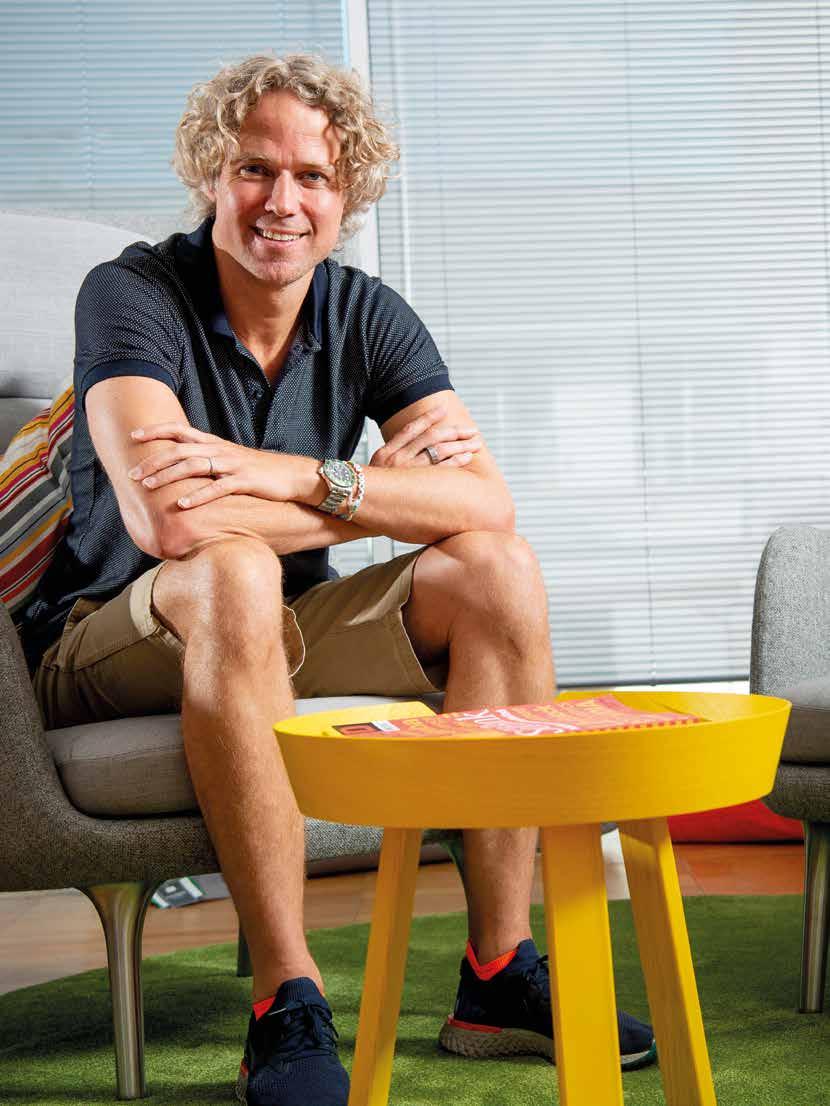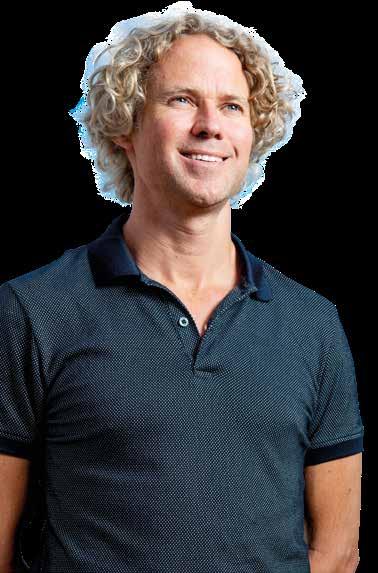
7 minute read
Tom Hulme: Entrepreneur to investor
Since spinning out of Google ten years ago, GV, formerly known as Google Ventures, has backed founders who transform existing industries and even create completely new ones. W ith over 300 active portfolio companies, $4.5 billion under management, and over 100 mergers and acquisitions, it’s safe to say that GV’s investors know their stuff. Heading up GV’s European arm is General Partner Tom Hulme, serial entrepreneur, TEDTalker, design guru and investor extraordinaire.
Advertisement
Recognised as a Young Global Leader by the World Economic Forum, featured in Wired UK’s Top 100 Digital Power Brokers, and included in the Evening Standard’s list of London’s 1,000 Most Influential People, Tom is not short of accolades recognising his achievements. But heading into the world of investment, design or entrepreneurship wasn’t always on Tom’s radar.
Before enrolling on the MBA at Harvard, Tom studied Physics at Bristol University. “I would love to shatter the myth that most people have a really clear career plan. At university I was petrified that I didn’t have an explicit plan for the next 20 years. However, I’ve always tried to do interesting stuff. I’ve rarely been the smartest person, but I’ve been willing to work as hard as anyone else.”
Tom’s career has been built on his interest in creating, his curiosity about the new and a drive for impact. “From a young age I wanted to build stuff and create experiences, create products and create services that other people benefit from. Probably the first instance was putting my poor sister at the end of our drive and having her sell apples, which I felt bad about afterwards because I didn’t give her much of the proceeds!”
Tom’s life experiences helped strengthen his interests and forge what would turn out to be a hugely successful career path. “I went and worked in Africa for a year as a teacher in a secondary school, which reminded me that I wanted to do stuff that was going to be impactful. Then I ran a nightclub once a week while I was at university. Together, this stuff made me realise that I’d rather be my own boss and have a positive impact, and that, for me, is entrepreneurship.”
From this point, Tom had success after success with the companies he joined. At just 22, while still studying physics, Tom worked in the parts department of a car manufacturer, Marcos: “While there, I designed a software programme that enabled the management of the parts. After finishing university, I went back to run the factory and ended up Managing Director and making it profitable by moving it from road cars into race cars.” This experience demonstrated Tom’s ability not only to design products, but to design hugely successful businesses. Tom had the opportunity to exploit both of these skills when he founded engineering design company Magnom. The company commercialised a patented magnetic filter Tom designed, which is now widely used in Ferrari Formula One cars, superbikes, JCB loaders and central heating systems.
Tom’s passion for design engineering, and undeniable skill for business, led him to embark on an MBA at Harvard while also teaching himself digital design in his spare time. After graduating, Tom was appointed Design Director at IDEO, a global design consultancy committed to creating positive impact. At IDEO, Tom saw an opportunity to use more people to solve even bigger design challenges: “The question I asked was, why don’t we involve everyone in every design and find a process whereby anyone could contribute? So, I asked IDEO, ‘are we able to open up the design process to everyone for social good?’, which is what we did. We created OpenIDEO.
“For me, entrepreneurship is understanding which questions you need to solve and prioritising the order in which you solve them. I wasn’t sure if it was going to work, so initially I created a Facebook page to see whether we had the convening power to get people to participate, because that was my greatest fear.”
Tom founded OpenIDEO in 2010, a platform that allows a global community of users to tackle global challenges. The platform now has over 150,000 users from more than 170 countries. “Some of the most rewarding things are not the ideas and the impact, they’re the small anecdotes from people who have got into the design industry because of the muscles they built on the platform. To see people from across the globe collaborating to solve a problem is pretty extraordinary. And, for the first time, it’s not people in the west designing for people in Sub-Saharan Africa, it’s everyone designing for everyone.”
Tom’s top reads:
Phil Knight’s Shoe Dog, the Nike founding story, which is the exact opposite. It’s a reminder that if you’re determined and you have integrity, then you can get through almost anything.
The Innovator’s Solution by Clay Christensen gives a wonderful list of ways that startups’ incumbents are vulnerable, not because they’re stupid but because they’re actually rational and still make bad decisions.
Bad Blood, by John Carreyrou, a cautionary tale of when it goes wrong. Daniel Kahneman’s
Thinking, Fast and Slow, the best book on behavioural economics. And a bit of science fiction, The Three-Body Problem by an awesome Chinese writer, Cixin Liu.
Tom’s skills in design engineering earned him a TED speaker’s slot. Titled ‘What can we learn from shortcuts?’ Tom’s talk looked at the intersection of design and user experience, where people have developed their own desire paths out of necessity. “It’s really just an exercise in humility, realising that the people that we create products and services for probably don’t use them in exactly the way we imagined and, actually, I find that exciting.” The video has been viewed more than 1.5 million times to date, but Tom has never watched it: “I hate seeing myself. I hate hearing my own voice – I definitely don’t want to watch myself on video!”
Now General Partner at GV, Tom is responsible for investing millions in
up-and-coming ventures, including Uber, Slack and Secret Escapes, among many others. “I love it. It’s an incredible platform to meet smart and interesting people. My day job is trying to find entrepreneurs who will create businesses of the future by serving customer needs in innovative new ways.” GV is industry agnostic, which allows Tom and the GV team to invest in a wide variety of companies spanning everything from consumer and healthcare to fintech and cyber security. “I’m proud of the investments we’ve made. Sometimes it’s supporting incredibly high-functioning teams; sometimes it’s more about the impact it will have to human health.”
GV invests in these companies through the varied expertise of the team as well as capital. Tom explains: “We have experts who spend time with teams and help them to not make the mistakes we’ve seen a bunch of times before.”
When deciding who to invest in, both in his role at
1
GV and as an angel investor, Tom says he’s deeply suspicious when he meets an entrepreneur who has a 50-page business plan: “It’s usually a bad use of their time. They’d be better off going out into the world and testing their hypothesis. The answer is usually outside the building and perfection can be the enemy of progress. You can spend too much time trying to get something perfect when actually if you err towards openness, taking it out into the world and getting feedback, you’ll
2
learn much faster and much more efficiently.”
The quality of the pitches Tom sees nowadays is incredibly high, so to determine the good investment opportunities form the bad, Tom looks for a few key differentiators: “What’s the problem being solved? It’s very rare that there’s a completely new market; that it’s completely novel. Is this team uniquely placed to solve this problem? What is it about this team that has an unfair advantage? Does it matter? And, to some extent, can we add value or help them on that journey?
It’s absolutely essential that we believe we can make that difference. The best pitches have some kind of customer or market validation.”
3
Tom’s top five investment tips:

Be very clear about how much you need to raise in order to get to the next proof point or value inflection point.
4
Be pragmatic. Don’t be overly focused on valuation. People overstate the importance of a high valuation and probably understate the importance of everything else, and so view the whole package from the investor.
Practise on investors that are lower priority because pitching takes practice. You wouldn’t want your first pitch to be the most important.
5
Understand what questions you’re answering and, in cases where you’ve not already answered them, explain why.
Have a clearly defined list of investors and understand why you’re approaching them. Do due diligence on the investor in the same way the investor does due diligence on you. It blows my mind that a founder wouldn’t call up the CEOs of the companies that I’ve invested in before to ask what it’s like to work with me but that happens unbelievably infrequently.










